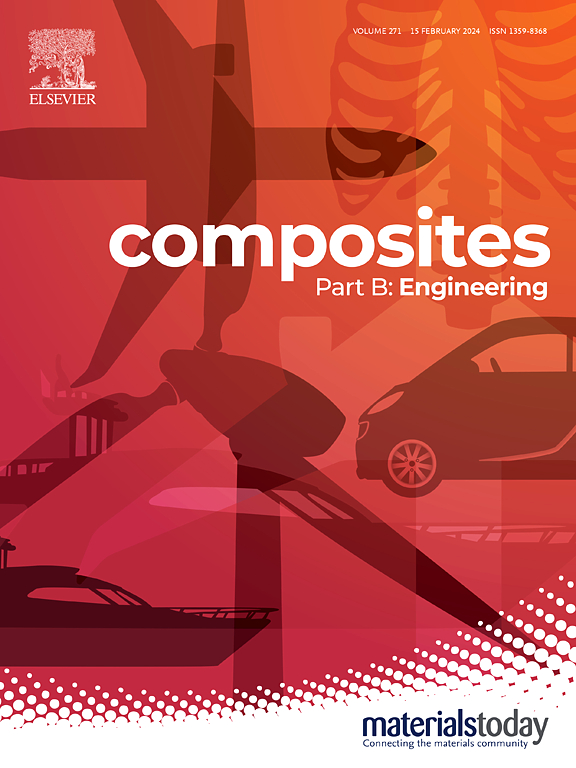用于慢性疾病监测和健康监测的多功能复合离子凝胶传感器
IF 12.7
1区 材料科学
Q1 ENGINEERING, MULTIDISCIPLINARY
引用次数: 0
摘要
用于实时健康监测的柔性传感器对于慢性病的早期发现和长期管理至关重要。尽管现有的健康监测系统提供了有价值的见解,但它们往往受到功能、对外部电源的依赖以及与便携性和用户舒适度相关的挑战的限制。在此,我们提出了一种由聚偏氟乙烯(PVDF)复合离子凝胶制成的自供电柔性传感器,该传感器具有抗冻、高强度、抗菌性能和生物相容性。作为摩擦纳米发电机传感器的摩擦层和导电层,Cu(NO3)2和多壁碳纳米管(MWCNTs)的协同作用显著提高了复合离子凝胶的输出性能,输出电压提高了4.23倍。开发的压力传感器在0.32-1.69 kPa范围内的灵敏度为2.66 V kPa−1,能够有效监测人体运动和应用,如手语识别和慢性疾病监测,包括阻塞性睡眠呼吸暂停低通气综合征(OSAHS)。此外,MWCNTs的掺入使传感器具有优异的热敏性(0.456°C−1),从而实现准确的实时体温监测。这些多功能离子凝胶传感器集成了实时生理信号跟踪,在推进可穿戴医疗技术和个性化医疗解决方案方面具有巨大潜力。本文章由计算机程序翻译,如有差异,请以英文原文为准。

Multifunctional composite ionogel-based sensors for chronic disease surveillance and health monitoring
Flexible sensors for real-time health monitoring are vital for early detection and long-term management of chronic diseases. Despite the valuable insights provided by existing health monitoring systems, they are often limited by functionality, dependence on external power sources, and challenges related to portability and user comfort. Herein, we presented a self-powered flexible sensor fabricated from a polyvinylidene fluoride (PVDF) composite ionogel that offers frost resistance, high strength, antibacterial properties, and biocompatibility. As both the friction and conductive layers in a triboelectric nanogenerator-based sensor, the composite ionogel's output performance is significantly enhanced by the synergistic effects of Cu(NO3)2 and multi-walled carbon nanotubes (MWCNTs), resulting in a 4.23-fold increase in output voltage. The developed pressure sensor exhibits a sensitivity of 2.66 V kPa−1 within a range of 0.32–1.69 kPa, enabling effective monitoring of human motion and applications such as sign language recognition and chronic disease monitoring, including obstructive sleep apnea hypopnea syndrome (OSAHS). Furthermore, the incorporation of MWCNTs imparts exceptional thermal sensitivity (0.456 % °C−1) to the sensor, allowing accurate real-time body temperature monitoring. These versatile ionogel sensors, which integrate real-time physiological signal tracking, have significant potential to advance wearable medical technologies and personalized healthcare solutions.
求助全文
通过发布文献求助,成功后即可免费获取论文全文。
去求助
来源期刊

Composites Part B: Engineering
工程技术-材料科学:复合
CiteScore
24.40
自引率
11.50%
发文量
784
审稿时长
21 days
期刊介绍:
Composites Part B: Engineering is a journal that publishes impactful research of high quality on composite materials. This research is supported by fundamental mechanics and materials science and engineering approaches. The targeted research can cover a wide range of length scales, ranging from nano to micro and meso, and even to the full product and structure level. The journal specifically focuses on engineering applications that involve high performance composites. These applications can range from low volume and high cost to high volume and low cost composite development.
The main goal of the journal is to provide a platform for the prompt publication of original and high quality research. The emphasis is on design, development, modeling, validation, and manufacturing of engineering details and concepts. The journal welcomes both basic research papers and proposals for review articles. Authors are encouraged to address challenges across various application areas. These areas include, but are not limited to, aerospace, automotive, and other surface transportation. The journal also covers energy-related applications, with a focus on renewable energy. Other application areas include infrastructure, off-shore and maritime projects, health care technology, and recreational products.
 求助内容:
求助内容: 应助结果提醒方式:
应助结果提醒方式:


